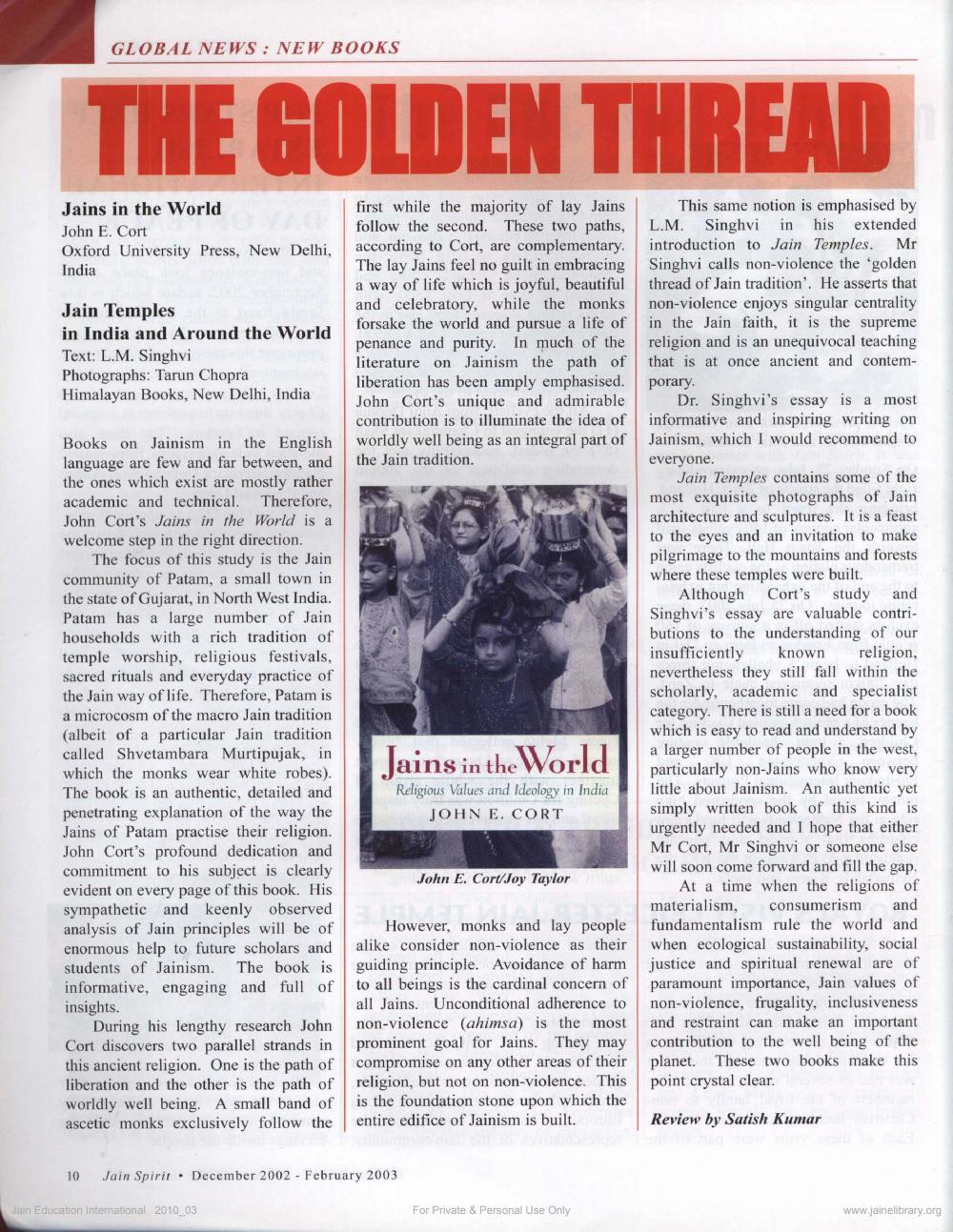________________
GLOBAL NEWS: NEW BOOKS
THE GOLDEN THREAD
Jains in the World
John E. Cort
Oxford University Press, New Delhi, India
Jain Temples
in India and Around the World Text: L.M. Singhvi
Photographs: Tarun Chopra Himalayan Books, New Delhi, India
Books on Jainism in the English language are few and far between, and the ones which exist are mostly rather academic and technical. Therefore, John Cort's Jains in the World is a welcome step in the right direction.
The focus of this study is the Jain community of Patam, a small town in the state of Gujarat, in North West India. Patam has a large number of Jain households with a rich tradition of temple worship, religious festivals, sacred rituals and everyday practice of the Jain way of life. Therefore, Patam is a microcosm of the macro Jain tradition (albeit of a particular Jain tradition called Shvetambara Murtipujak, in which the monks wear white robes). The book is an authentic, detailed and penetrating explanation of the way the Jains of Patam practise their religion. John Cort's profound dedication and commitment to his subject is clearly evident on every page of this book. His sympathetic and keenly observed analysis of Jain principles will be of enormous help to future scholars and students of Jainism. The book is informative, engaging and full of insights.
During his lengthy research John Cort discovers two parallel strands in this ancient religion. One is the path of liberation and the other is the path of worldly well being. A small band of ascetic monks exclusively follow the
10
.
first while the majority of lay Jains follow the second. These two paths, according to Cort, are complementary. The lay Jains feel no guilt in embracing a way of life which is joyful, beautiful and celebratory, while the monks forsake the world and pursue a life of penance and purity. In much of the literature on Jainism the path of liberation has been amply emphasised. John Cort's unique and admirable contribution is to illuminate the idea of worldly well being as an integral part of the Jain tradition.
Jain Education International 2010_03
Jains in the World
Religious Values and Ideology in India JOHN E. CORT
Jain Spirit December 2002 February 2003
John E. Cort/Joy Taylor
However, monks and lay people alike consider non-violence as their guiding principle. Avoidance of harm to all beings is the cardinal concern of all Jains. Unconditional adherence to non-violence (ahimsa) is the most prominent goal for Jains. They may compromise on any other areas of their religion, but not on non-violence. This is the foundation stone upon which the entire edifice of Jainism is built.
For Private & Personal Use Only
This same notion is emphasised by L.M. Singhvi in his extended introduction to Jain Temples. Mr Singhvi calls non-violence the 'golden thread of Jain tradition'. He asserts that non-violence enjoys singular centrality in the Jain faith, it is the supreme religion and is an unequivocal teaching that is at once ancient and contemporary.
Dr. Singhvi's essay is a most informative and inspiring writing on Jainism, which I would recommend to
everyone.
Jain Temples contains some of the most exquisite photographs of Jain architecture and sculptures. It is a feast to the eyes and an invitation to make pilgrimage to the mountains and forests where these temples were built.
and Although Cort's study Singhvi's essay are valuable contributions to the understanding of our known insufficiently. religion, nevertheless they still fall within the scholarly, academic and specialist category. There is still a need for a book which is easy to read and understand by a larger number of people in the west, particularly non-Jains who know very little about Jainism. An authentic yet simply written book of this kind is urgently needed and I hope that either Mr Cort, Mr Singhvi or someone else will soon come forward and fill the gap.
At a time when the religions of materialism, consumerism and fundamentalism rule the world and when ecological sustainability, social justice and spiritual renewal are of paramount importance, Jain values of non-violence, frugality, inclusiveness and restraint can make an important contribution to the well being of the planet. These two books make this point crystal clear.
Review by Satish Kumar
www.jainelibrary.org




